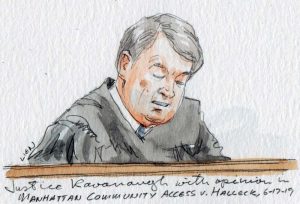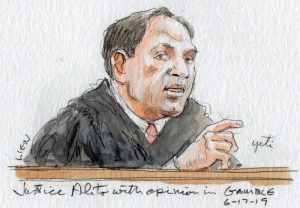A “view” from the courtroom: A search for the elusive end of the term

on Jun 17, 2019 at 3:45 pm

The end of the term is in sight, though with 24 decisions in argued cases remaining this morning, much work is left to do.
Yet there is still time for short seasonal diversions for those who work in the court building and those who cover the court. Last Wednesday, according to the court’s newsletter, was the annual employee awards ceremony, followed by a cookout. (The grilling occurs in one of the court building’s interior courtyards.) And this coming Thursday, the annual end-of-term party, when the justices’ law clerks typically put on satirical skits, will be held in the East and West Conference Rooms.
The Supreme Court press corps is not invited to those events, but we did have our annual group outing to the Washington Nationals baseball game this past Saturday. The game against the Arizona Diamondbacks was also promoted as Star Wars Day. Several of us who arrived more than an hour before game time were disappointed that all 10,000 bobbleheads featuring Nationals pitcher Sean Doolittle in an Obi “Sean” Kenobi costume had already been distributed to early arrivals. The promotion also featured actors dressed up as Star Wars characters walking the concourses (including an impressively realistic Chewbacca), as well as children charmingly decked out as Princess Leia, Luke Skywalker, Darth Vader and at least one out-of-place Harry Potter.
The bobblehead disappointment did give me a promotional idea. Perhaps the baseball team’s marketing department could join forces with the Green Bag law journal, known for its bobbleheads of Supreme Court justices, and SCOTUSblog’s artist, Art Lien, who in 2015 drew a banner featuring the justices as baseball players (well, most of them as baseball players, and Chief Justice John Roberts as the umpire, of course). It would be “Supreme Court Justices in Baseball Uniforms Bobblehead Day.”
The courtroom is full today, with some typical seasonal visitors. Participants in the Supreme Court Summer Institute for Teachers, the training session for high-school teachers who teach about the court, are here with Lee Arbetman, the executive director of Streetlaw, which is a co-sponsor of the institute along with the Supreme Court Historical Society.
Every year, the institute participants hold a moot court about a big case from the current term. This year, the institute mooted The American Legion v. American Humanist Association, about whether the Bladensburg Peace Cross, on public land in Bladensburg, Md., violates the establishment clause.
The bar section is packed this morning because it is the last day for courtroom bar admissions this term. Among those who will be sworn in at the end of today’s session are groups from the Chicago-Kent College of Law, Georgetown University Law Center and the National Organization of Social Security Claimants’ Representatives.
When the justices take the bench, all are present for the first time in a few weeks. The chief justice announces that Justice Brett Kavanaugh has the opinion in Manhattan Community Access Corp. v. Halleck.
This is one of the cases this term about cutting-edge technology of an earlier era, because it involves whether a cable-television provider of public-access channels is a state actor subject to the First Amendment. (The other cases along that cutting-edge line included one about technology to speed along misdelivered mail and one about fax machines.)
The Manhattan Community Access case also provided a lively oral argument, with Justice Stephen Breyer posing hypotheticals about a public-access TV series about New York hot dogs.
Kavanaugh, in summarizing his opinion, notes that “since the 1970s,” when public-access channels became a feature of cable systems, both private and public actors have operated such channels.
He says that when a private entity provides a forum for speech, the private entity “is not ordinarily constrained by the First Amendment,” and he mentions that the court held “in an important 1976 decision” — Hudgens v. National Labor Relations Board — “that a shopping center owner was not a state actor subject to First Amendment constraints.”
Private property owners often open up their property for speech, he notes, citing grocery stores putting up community bulletin boards, comedy clubs hosting open mic nights and bookstores holding author events.
“If the rule were otherwise, … private property owners would face the unappetizing choice of allowing all comers or closing the platform altogether,” Kavanaugh says. “Benjamin Franklin once said that he did not have to operate his newspaper as ‘a stagecoach, with seats for everyone.’ That is still true.”
It seems like a bit of a mixed metaphor, but who are we to question Ben Franklin?
Kavanaugh quickly dispenses with an alternative argument of the respondents in this case, some filmmakers who were denied access to the Manhattan Neighborhood Network, the public-access channel. He announces that Justice Sonia Sotomayor has the dissent, joined by Breyer and Justices Ruth Bader Ginsburg and Elena Kagan. Sotomayor has a snappy opening to her dissent, but she doesn’t read it from the bench.
Justice Neil Gorsuch is up next with the announcement in Virginia Uranium Inc. v. Warren, which was argued Nov. 5 and is the second-longest pending case of the term, after Gundy v. United States from the October sitting.
Gorsuch has only a plurality opinion, though he masks that fact somewhat as he announces that the court rejects Virginia Uranium’s arguments that the federal Atomic Energy Act pre-empts a Virginia law that prohibits the mining of uranium within the state’s borders.
U.S. Solicitor General Noel Francisco, who had argued as an amicus in support of Virginia Uranium, is not here today. His office’s delegation is led by Principal Deputy Solicitor General Jeffrey Wall, along with deputies Edwin Kneedler and Malcolm Stewart.
Gorsuch announces that Justices Clarence Thomas and Kavanaugh join his opinion, while Ginsburg has filed an opinion concurring in the judgment joined by Sotomayor and Kagan. Roberts has filed a dissent, joined by Breyer and Justice Samuel Alito.
The chief justice announces that Alito has the opinion in Gamble v. United States, about whether the double-jeopardy clause of the Fifth Amendment bars separate prosecutions by separate sovereigns for the same crime.
As Alito begins, Gorsuch receives a note, evidently from the chief justice. Gorsuch reads the note and smiles, then turns toward Roberts, who gives a nod of acknowledgement.
Alito is typically given to very brief summaries of his majority opinions except in major cases. Today, he will still be relatively brief, but he will also have the courtroom in stitches, however briefly, and that is not something you can say every day.
The case is a challenge to the court’s longstanding interpretation of the double-jeopardy clause as not barring separate-sovereign prosecutions for the same crime by Terance Martez Gamble, who pleaded guilty to violating Alabama’s felon-in-possession-of-a-firearm statute, and now faces a separate prosecution for the same offense under the federal felon-in-possession law.
Gamble’s arguments rest on the idea that the double-jeopardy clause forbids successive prosecutions by different sovereigns because that is what founding-era common law provided.
But from the bench, Alito says, “[W]e have painstakingly researched the text of the Fifth Amendment” and other evidence. “We adhere to the position that we have taken for well over a century.”
In response to Gamble’s originalist arguments, Alito says, “we have looked high and low” and “dusted off 16th and 17th century” law treatises to examine Gamble’s arguments.
As the written opinion points out, these include English cases before such ancient forums as the Court of King’s Bench and the High Court of Chivalry.
“This search has turned out to be very much like the search for the Yeti,” Alito says in reference to the figure also known as the Abominable Snowman or the Sasquatch.
The courtroom has already perked up over Alito’s enthusiastic delivery, and the Yeti reference generates laughs.
He continues in this vein, suggesting that Gamble’s arguments for originalist support amount to a “grainy photo” and “muddy footprints,” but no convincing evidence. (There is no trace of Alito’s references to the Yeti — not even a muddy footprint — in his written opinion.)
“It takes a lot more than that to overturn” 170 years of precedent, Alito says. The precedent, and the decision below, are affirmed, with Thomas filing a concurring opinion and Ginsburg and Gorsuch filing separate dissents.
Next up is Ginsburg, with the decision in Virginia House of Delegates v. Bethune-Hill.
She is not wearing the jabot she usually wears when delivering a majority opinion. That is not the only thing that is amiss.
When she starts speaking about this racial-gerrymandering case, her voice is quite hoarse. The court’s public information office will later confirm that she is suffering from a cold and laryngitis.
She presses on with the opinion in a case that has been here before, in which a federal district court found that 11 state legislative districts were racially gerrymandered in a map drawn up after the 2010 census. The Virginia House of Delegates intervened to defend the map after the state’s attorney general declined to appeal.
The court has found that the House of Delegates lacks standing to carry on the appeal.
“In short, Virginia would rather stop than fight on,” Ginsburg says. “One house of its bicameral legislature cannot alone continue the litigation against the will of its partners in the legislative process.”
At times, her voice gains a bit of strength, but at other times it weakens to a whisper, and even some of her colleagues turn toward her as if to will her some vocal strength.
After several strained minutes, Ginsburg says, “For the reasons just summarized and explained more completely in the court’s opinion, we dismiss the House of Delegates’ appeal for want of jurisdiction.”
She announces the unusual lineup. Alito has written the dissent, joined by Roberts, Breyer and Kavanaugh. She then leans back, grabs her tall to-go mug and takes several extra-long sips of whatever beverage it contains.
After the bar admissions, all eyes turn to Marshal Pamela Talkin, who announces that court is in recess until Thursday. It will be the first extra opinion day of the term, and with 20 opinions remaining, we all may need a big gulp of something to be ready for it.






